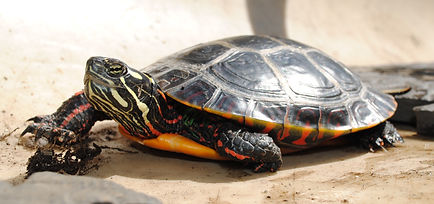
Constance Browne, PhD; Ecologist
Last Updated February 2021
Turtle Research in New Brunswick
Turtle populations have been declining worldwide. Threats to populations in Canada include habitat loss and degradation, road mortality, accidents with recreational vehicles, agricultural machinery, and boat propellers, increased predation by subsidized predators, bycatch from fishing, dredging, road grading, water drawdowns, pollution, and collection (for food or pets). The life history characteristics of turtles make them more susceptible to anthropogenic threats than other organisms; therefore, they may need extra protection/mitigation in order to persist in areas used by humans. My goal is to determine the distribution and status of turtle populations focussing on the Saint John area.
To determine the distribution of turtles, I'm collecting observations from the public and also sampling wetlands using turtle live traps. Each turtle that is caught is measured and marked with a unique identification code. When sample sizes permit, I can examine age structure, sex ratios, and population size with this data, which is used to assess population status.
New Brunswick is home to three native species of turtles, plus the exotic red-eared slider. So far, my research has confirmed that snapping turtle and painted turtle populations are present in Rockwood Park, and red-eared sliders also occur. Snapping turtles appear to be widespread, but at very low densities. The painted turtles appear to be concentrated in just one area within the park. Red-eared sliders can be found in the recreation area (Lily and Fisher Lakes).
In 2016, we plan to 1) collect data from the painted turtle population to calculate survival estimates and population size, 2) continue sampling at new sites to map the distribution of turtle populations in the city, 3) catch, remove, and rehome exotic red-eared slider turtles from First Arch and Lily Lakes, 4) assess threats to our turtle populations and develop a conservation plan for how to protect turtle populations in Saint John.
One of the potential threats that we’re assessing is accidental by-catch by anglers. Our goal is to gauge the frequency of turtle by-catch and extent of hook injuries. If angling is a significant threat to turtle populations, then we plan to develop guidelines to minimize angling impact (e.g., when hooked individuals should be released versus when medial help should be sought). If you fish, please complete the survey on the "Angler Survey" tab to help us understand turtle and fishing interactions.
If you see a turtle, from anywhere in New Brunswick, please record the date, location, coordinates, species, description of the turtle, and if possible take a picture, but please do not disturb the turtle. Please submit your observations to the Atlantic Canada Conservation Data Centre or iNaturalist

Turtle Tracks
I'm another title

Eastern Painted Turtle
Painted turtles are widespread in Canada and occur from Nova Scotia to British Columbia. The status of eastern painted turtles in Canada is unknown, but is currently under review by COSEWIC (Committee on the Status of Endangered Wildlife in Canada). One population of eastern painted turtles has been documented in Saint John. Preliminary results indicate that this population is small, but apears to be healthy.

Snapping Turtle
Snapping turtles have declined in Canada and are considered to be a species of Special Concern by COSEWIC. Snapping turtles are present in Saint John, but we do not have enough data to assess their population health.

Wood Turtle
Wood turtles are listed as a Threatened Species in Canada. Wood turtles have occassionally been observed in Saint John, but it is not known whether populations exist or if these were individuals that were displaced by humans.

Red-eared Slider Turtle
Red-eared sliders are native to southeastern United States. They were brought to Canada and sold in pet stores, but some people who purchased the tiny babies were unaware of how large they grew or how long they lived, and unfortunately some owners have released their pets into the wild. Red-eared sliders have been observed in Lily Lake, Fisher Lakes, and First Arch Lake in Rockwood Park. These turtles are a threat to our native species because they may compete for food or basking sites and they could be carrying exotic diseases which our native species may not be immune to. We have caught and removed five individuals from the Saint John area. Two individuals have been rehomed to forever families. The other three live at the Interpretation Centre in Rockwood Park and can be visited during open hours.
Sponsored by:
Your Environmental Trust Fund at Work
-
Votre Fonds en fiducie pour l'environnement au travail
Our project is funded in part by the New Brunswick Wildlife Trust Fund. This Wildlife Trust Fund obtains a portion of its revenue from the purchase of conservation plates by New Brunswick residents who are interested in conservation. Seven dollars ($7) from each conservation plate purchase goes into that fund annually. These funds are awarded to projects such as ours by the Minister of Natural Resources following review and recommendation by an independent board of 17 volunteers. Revenue from license plates is critical in furthering conservation efforts in our province so please consider purchasing conservation plates with your next car purchase to enable the NB Wildlife Trust Fund to continue to provide financial support for worthy wildlife projects.
And Many Volunteers
Last Updated June 2016




